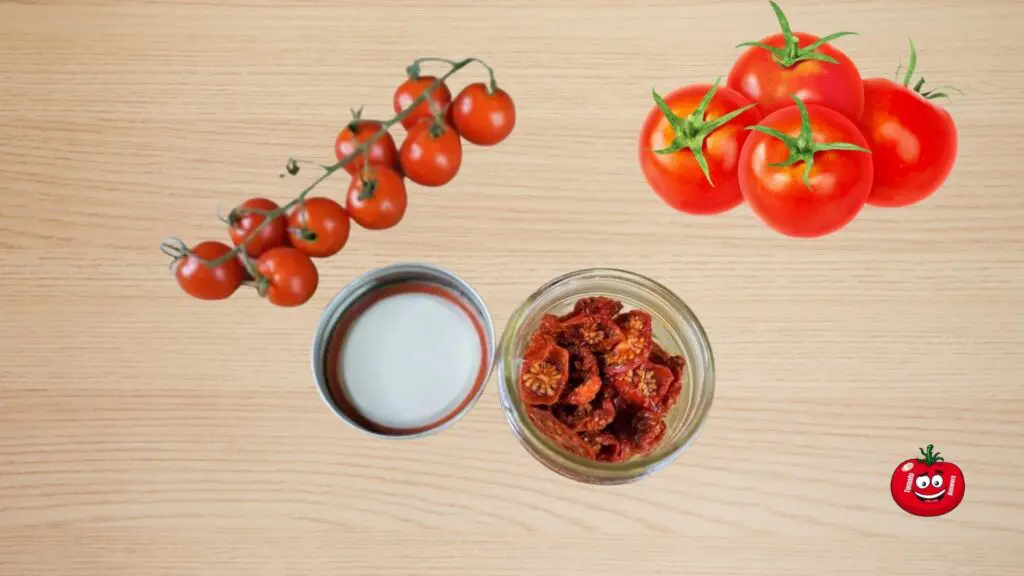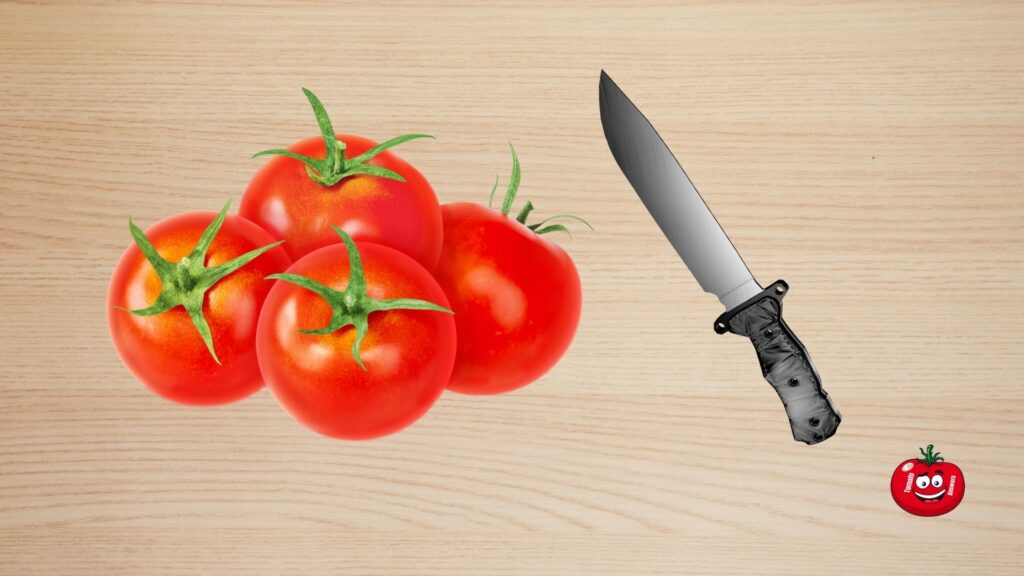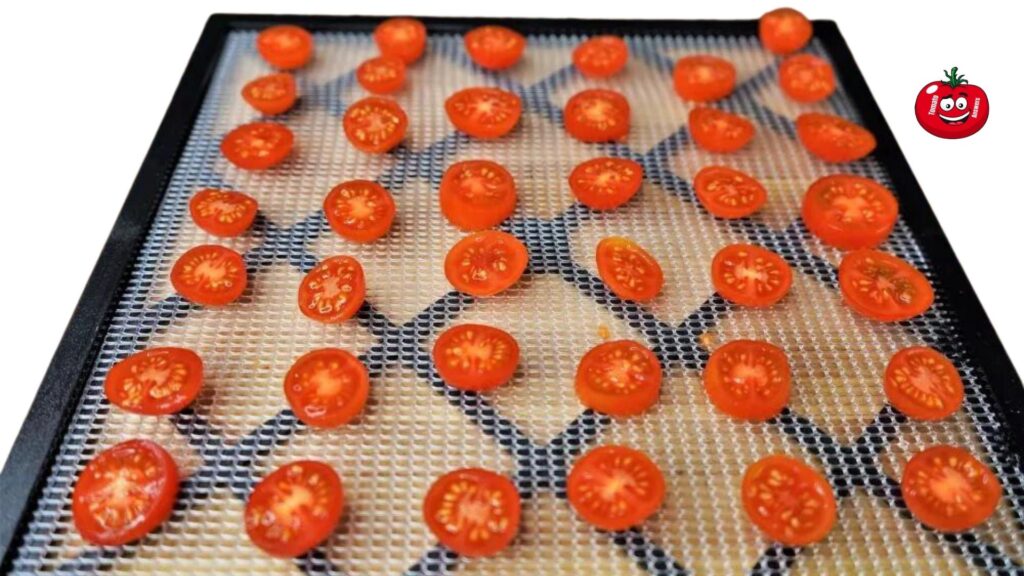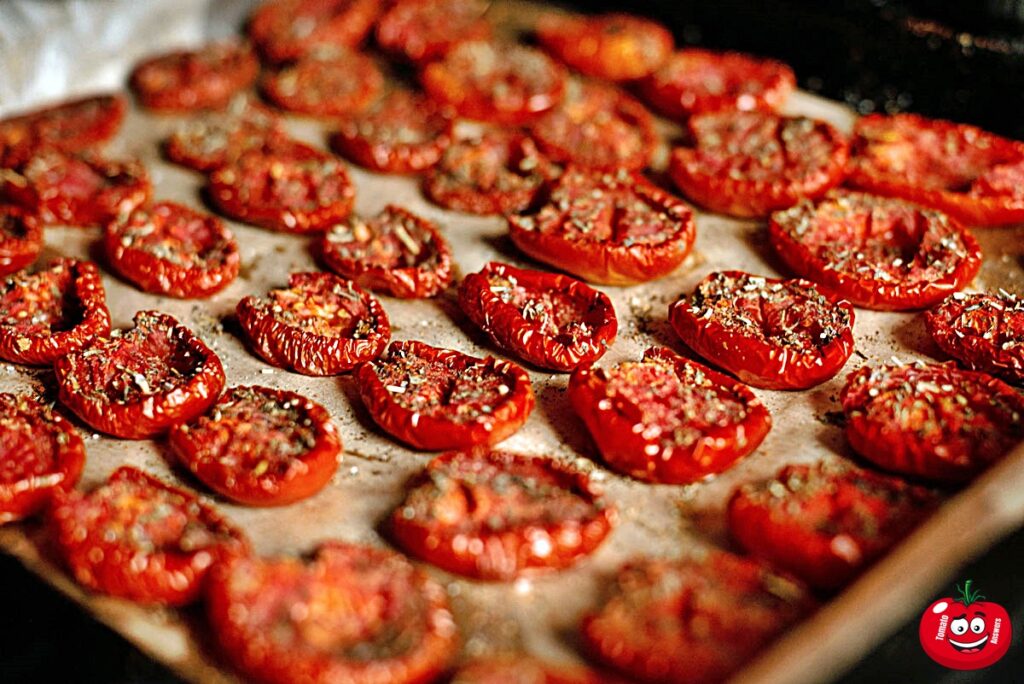A food dehydrator can alter how you utilize your garden’s produce. Virtually any type of food can be dehydrated for preservation, including tomatoes. This article will discuss the methods I use to dehydrate cherry tomatoes.
Dehydrated cherry tomatoes are cherry tomatoes that have had their moisture removed through dehydration.
Here are some more details:
- Dehydration involves using low, consistent heat to slowly draw moisture out of foods. For tomatoes, the ideal dehydrator temperature is 130-140°F.
- Cherry tomatoes are a good candidate for dehydration because of their small, dense size and low moisture content compared to regular tomatoes.
- To dehydrate, cherry tomatoes are washed and sliced in half or quarters, then cut side up on dehydrator trays.
- It takes roughly 6-12 hours for cherry tomatoes to dehydrate, becoming shriveled, dry, and brittle fully.
- Once dehydrated, the tomatoes have concentrated tomato flavour and scent. Their texture becomes almost chip-like and crunchy.
- Dehydrated tomatoes are shelf-stable and can be stored for up to 1 year in airtight containers out of sunlight.
- Rehydrating dehydrated cherry tomatoes in hot water or broth allows them to be used as flavouring in soups, sauces, stews, rice dishes, and more.
- They also make a healthy snack, adding a burst of tomato taste.
So, dehydrated cherry tomatoes are a dried, concentrated form of cherry tomatoes created by removing their moisture content. This preserves them and intensifies their flavour.
In This Article
Dehydrating Cherry Tomatoes: Savor the Taste Year-Round
Whether you grow them in pots or purchase them from a store, these small snacks are ideal for long-term storage. Let’s begin!
Dehydration Methods For Cherry Tomatoes:
There Are 5 Dehydration Methods For Cherry Tomatoes.
Due to the high water content in tomatoes, air drying is not recommended. Instead, consider using one of these basic methods for drying your cherry tomatoes at home.
- The preferred method for drying fruit and vegetables is a dehydrator. These machines can circulate air while maintaining a low temperature, ensuring even drying. They have non-stick screen trays, eliminating the need to flip the food. This method results in quicker drying times and preserves the maximum flavor.
- You can use an oven to dehydrate cherry tomatoes if needed. Convection ovens are especially helpful because the circulating air speeds up drying. However, standard ranges take longer to dry the tomatoes fully. Another downside is that oven temperatures typically can’t be set below 200°F, which can cook the tomatoes and affect their flavor and appearance.
- You often find sun-dried tomatoes in the supermarket. Drying tomatoes in the sun is a viable method for dehydrating them, but it’s important to follow a proven technique. If the tomatoes don’t dry quickly enough, mould or fungus can ruin them. Skip to the sun-dried method.
If these options are not suitable, it may be advisable to consider alternative preservation methods. It is not recommended to air-dry indoors.
1. Dehydrating Cherry Tomatoes In The Dehydrator
Using a food dehydrator is considered the most effective way to dry tomatoes. They can be compared to an easy-bake-oven, specifically designed for adult gardeners.
I understand that not everyone may find it necessary to purchase a food dehydrator, but if you’re interested in drying your cherry tomatoes, I can share my experience with you.
I have used my dehydrator extensively, making beef jerky, fruit leather, dehydrated tomatoes and peppers, mushrooms, and more.
Drying food is a common method used for long-term preservation. It involves reducing the size of the food, removing moisture to prevent mould, and often enhancing flavours. If you have a sizable garden, using a dehydrator can be beneficial in extending the shelf life of your harvests.
I use a dehydrator for all my food-drying needs.
Dehydrating Cherry Tomatoes In The Dehydrator (Steps)
- When dehydrating cherry tomatoes, selecting ripe, healthy-looking ones is important. Avoid any mouldy or rotted parts, and remove any imperfect parts before drying them.
- First, prepare the tomatoes, ensure they are clean and dry. Rinse them under cool water and dry them completely. Additionally, remove any stems you may find.
- You can slice cherry tomatoes in half or saucers. If the tomatoes are large, cut them into 1/4″ slices. Keep the slices consistent for even drying times. Avoid slicing them too thin, as they will become extremely thin when dried.
- To dehydrate tomatoes, place slices on dehydrator trays. Arrange them in a single layer. If desired, add a sprinkle of salt, pepper, or fresh herbs for specific dishes. Otherwise, leave them plain.
- To dehydrate tomatoes, set the temperature to 135°F and leave them for 8-12 hours. The drying time depends on the texture you want and the thickness of the slices. Air humidity can affect the process too. If you prefer a leathery texture, refrigerate them. For a crispier result, continue dehydrating until desired.
- To store the tomatoes, use an airtight container. Remove all air by submerging the container or sucking it with a straw. Use food-safe silica gel packets to keep the tomatoes dry during storage. If the tomatoes are still pliable, store them in the refrigerator for a longer shelf life, up to 2-3 months. If the tomatoes are fully dehydrated and brittle, they can be stored in the pantry for up to a year. Remember to keep them away from direct light.
To ensure optimal storage, it is recommended to use a vacuum sealer. Alternatively, you can store items in Ziploc bags and remove excess air using a straw before sealing.
It is important to inspect dehydrated tomatoes for mould and any remaining moisture, as this can cause them to spoil. Additionally, it is advised to check for any unusual odours.
Discoloration is a common occurrence during dehydration. To maintain the vibrant colour, briefly soak your tomatoes in a diluted ascorbic acid (vitamin C) water solution before drying.
2. Dehydrating Cherry Tomatoes In The Oven
If you do not have a dehydrator, an alternative option is to use your oven. Certain newer models, such as toaster ovens, may have a dehydrated function, so checking your instruction manual is worth checking.
Conventional ovens are not designed for dehydration but can be used in a pinch. The main issues are temperature and air circulation. Most ranges cannot exceed approximately 200°F, so your tomatoes may cook instead of drying. This can result in changes to their flavour and colour.
Some ovens have air circulation, but not all. Convection ovens are more efficient for dehydrating cherry tomatoes as they work faster. In summary, draining in the oven will require more time.
Dehydrating Cherry Tomatoes In The Oven (Steps)
- To preheat the oven to the lowest temperature, set it to around 200°F. Keep in mind that most ranges cannot go lower than that. Allow the oven to preheat before proceeding. If possible, try setting it to approximately 145°F.
- When selecting tomatoes, it is important to choose ripe, healthy ones free from mould or insect damage.
- Rinse the tomatoes carefully under cool water and remove the stems to clean and dry them.
- Cut the cherry tomatoes into slices that are about 1/4″ thick. Make sure to keep the thickness consistent to ensure even dehydration times.
- Place the tomato slices in a single layer on an oven-safe drying tray. Set the tray on a baking sheet to catch any water that may drip.
- Bake the tomatoes for 6-12+ hours. Check them after 6 hours to see if they’re dry. If your oven has a convection option, use it for quicker drying. It may take 12 hours or more without convection, so check regularly.
- Store the tomatoes in an airtight container with silica gel packets. Refrigerate leathery tomatoes for 2-3 months. The pantry is suitable for more crisp dried tomatoes, which can be stored for up to a year.
Using higher heat instead of a dehydrator may result in some potential discolouration, but the tomato flavour and shelf life should remain unchanged.
3. Making Sun-Dried Cherry Tomatoes
Sunshine is amazing. It is necessary for growing large tomato plants. It can also be utilized to dry out harvested fruits.
Sun-drying tomatoes has been a method for many centuries. The sun was the best option before the dehydrator. It can still be done in warm, consistently dry climates. However, there are potential drawbacks to consider.
If you live in a rainy or humid climate, sun drying may not be the best option as the tomatoes must be brought indoors during rain and at night.
Additionally, if tomatoes are left outside in the sun, they may attract herbivorous animals looking for a delicious snack.
Finally, sun-dried tomatoes require several weeks to fully dry. An oven or dehydrator is recommended for a faster dehydration process.
If you are not intimidated by these potential problems, you can use the following method to make sun-dried cherry tomatoes.
Making Sun-Dried Cherry Tomatoes (Steps)
- When selecting tomatoes, opt for ripe ones free from mould or spots.
- First, clean and dry the tomatoes. Then, rinse and thoroughly dry them. Finally, remove the stems.
- To slice tomatoes, use a tomato knife to cut them into 1/4″ thick or thinner slices, as thicker pieces may take longer to sun-dry.
- Place the sliced tomatoes in a single layer on a screen or cookie sheet. A screen or cookie sheet allows air to circulate above and below the tomatoes, resulting in quicker drying.
- To improve flavour when drying tomatoes, sprinkle them with coarse sea salt. This releases some water content and enhances the taste. Although not essential, it is recommended for sun drying. If desired, you can add ground herbs and spices like oregano, thyme, and rosemary.
- To expedite sun-drying, use a paper towel and gently blot the cherry tomatoes, removing any excess water or moisture.
- Place the tomatoes in a location that receives ample sunlight. Increased sun exposure is preferable. Before making sun-dried tomatoes, it is advisable to consult the weather forecast and choose a dry and hot weather period.
- Tomatoes need protection from insects and animals. Use garden cloth or fencing to keep them safe. Pick a good spot for them.
- Tomatoes should be brought indoors at night. This should be done over several days. The kitchen, shed, or garage can protect the drying tomatoes. If they are in an unsealed location, keep the tomatoes covered.
- The drying time for tomatoes can range from 1-2 weeks or even longer, depending on the climate. Humidity, rain, sun exposure, and wind affect its length. You’ll know they’re ready when they have a leathery texture.
- Store the tomatoes in airtight containers such as Ziploc bags or vacuum-sealed containers for 2-3 months to ensure freshness.
Sun drying is a traditional method of drying tomatoes that some belief enhances the flavor. It can be a fun experiment to make your sun-dried tomatoes without using electricity.
4. Dehydrated Cherry Tomatoes In Oil
Preserving dehydrated cherry tomatoes in oil is a flavorful way to enjoy your garden’s bounty all year round. The dry tomatoes soaked in aromatic oil make a delicious addition to salads, pasta, and many more dishes. They’re easy to prepare and store, offering a concentrated burst of tomato flavour whenever you need it.
Dehydrated Cherry Tomatoes In Oil (Steps)
1. Start by washing the cherry tomatoes thoroughly under running water to remove any dirt or debris.
2. Cut the cherry tomatoes in half or leave them whole, depending on your preference.
3. Preheat your oven to a low temperature, around 200°F (93°C).
4. Place the cherry tomato halves or whole tomatoes on a baking sheet lined with parchment paper or a silicone baking mat.
5. Drizzle a small amount of olive oil over the tomatoes, ensuring each tomato is lightly coated.
6. Sprinkle salt and pepper over the tomatoes to enhance the flavour.
7. If desired, add some herbs or spices, such as garlic powder, dried oregano, or basil, to add flavour to the tomatoes.
8. Place the baking sheet in the oven and let the tomatoes dehydrate for approximately 4-6 hours. Keep an eye on them and rotate the baking sheet occasionally to ensure even drying.
9. The tomatoes are ready when they have shrunk in size, lost most moisture, and have a chewy texture. They should not be crispy like sun-dried tomatoes.
10. Remove the baking sheet from the oven and let the tomatoes cool completely.
11. Transfer the dehydrated cherry tomatoes to a clean, airtight container.
12. Add enough olive oil to cover the tomatoes completely, ensuring they are fully submerged.
13. Close the container tightly and store it in the refrigerator.
14. The dehydrated cherry tomatoes in oil can be stored in the refrigerator for up to 2 weeks.
5. Dehydrating Cherry Tomatoes In Air Fryer
Unleash your air fryer’s potential beyond crispy fries! Explore the art of dehydrating cherry tomatoes, turning these ruby-red garden gems into flavorful, nutrient-packed snacks. A simple method to preserve your summer bounty, giving you a taste of sunshine in every bite all year round. Let’s get drying!
Dehydrating Cherry Tomatoes In Air Fryer (Steps)
- Preheat your air fryer to 135 degrees Fahrenheit (57 degrees Celsius). This is the ideal temperature for dehydrating cherry tomatoes.
- Wash the cherry tomatoes thoroughly and pat them dry with a clean kitchen towel.
- Slice the cherry tomatoes in half. This will help them dehydrate more evenly and speed up the drying process.
- Place the halved cherry tomatoes in a single layer on the air fryer basket or tray. Make sure they are not overlapping or touching each other too closely.
- Set the air fryer timer for 4-6 hours, depending on the size and moisture content of the tomatoes. Check on them periodically to ensure they are drying evenly.
- After 2 hours of drying, remove the air fryer basket or tray and shake it gently to reposition the tomatoes. This will help prevent sticking and promote even drying.
- Continue dehydrating the tomatoes until they are shriveled and dry but still slightly pliable. The drying time can vary, so keep an eye on them and adjust the time as needed.
- Once the cherry tomatoes are dehydrated to your desired texture, remove them from the air fryer and let them cool completely.
- Store the dehydrated cherry tomatoes in an airtight container or jar. They can be stored at room temperature for several months.
- Enjoy homemade dehydrated cherry tomatoes in salads, pasta dishes, or as a healthy snack!
Can You Dehydrate Whole Cherry Tomatoes?
If you are interested in dehydrating cherry tomatoes with minimal preparation, you may have questions about whether they can be dried whole. Maintaining their original size might be significant for your specific purpose.
When dehydrating cherry tomatoes, it is recommended to pierce them to let moisture escape and prevent mould or rot. However, cutting them in half or into 1/4″ thick slices will result in faster drying.
If dehydration of the whole tomato is desired for presentation or any other purpose, puncture each tomato a few times with a fork or toothpick.
Alternatively, you could also slice off the very end of each tomato, although it would be more practical to cut them in half at that stage.
If you seek a faster method of preserving cherry tomatoes, consider freezing them whole.
Can You Over-Dehydrate Tomatoes?
Two levels of dehydration can be targeted, one for short-term storage and the other for long-term storage. The choice between the two will depend on the intended use.
Tomatoes cannot be over-dehydrated; a slightly pliable texture is typically preferred. Full dehydration results in a brittle texture, and extended drying may lead to cooking and flavour loss.
The tomatoes have a leathery texture. They are slightly chewy and great for snacking or salads. This method takes less time to dehydrate but may lead to mould because some water remains in the tomatoes. This is the texture I prefer.
Drying cherry tomatoes to a brittle texture is important for long storage. When bent, the tomatoes should crack half, indicating that most of the water has been removed. Store them in air-tight containers with silica gel to prevent rehydration. To use, rehydrate in hot water.
Before turning on the dehydrator, it is important to set your intentions. Check on the tomatoes regularly to ensure they reach your desired dryness level without going too far.
How Long Do Dehydrated Cherry Tomatoes Last?
Although I would like to say that your dehydrated cherry tomatoes will last indefinitely, they are unlikely to do so. This may be because you have consumed them all.
Dehydrated cherry tomatoes can last for varying lengths, ranging from 2 months to 1 year, depending on how they are stored and their dryness level. If you want to extend their shelf life, it is recommended to keep them in the refrigerator and use silica gel.
Both brittle dehydrated tomatoes and leathery dried tomatoes have their advantages and disadvantages. Consider your needs and preferences to determine the best option for you.
Vacuum sealing is an effective method to extend the shelf life of dehydrated cherry tomatoes. Avoiding oxygen, moisture, and bright light during storage is important.
FAQs About Dehydrated Cherry Tomatoes
Here are the questions and answers about dehydrating cherry tomatoes.
1. Can cherry tomatoes be dehydrated?
Yes, cherry tomatoes can be dehydrated. Their small size and texture make them well-suited for dehydration.
2. Do you need to blanch tomatoes before dehydrating?
Blanching cherry tomatoes before dehydrating is unnecessary, but cracking the skins can help speed up the drying process. Blanch briefly in boiling water.
3. Should tomatoes be dehydrated with the skin on?
Most sources recommend dehydrating cherry tomatoes with the skins on. The skins help keep the tomato structure intact during dehydration.
4. Do you need to slice cherry tomatoes before dehydrating?
It’s best to slice cherry tomatoes in half or quarters before dehydrating to expose more surface area to dry out. Leaving them whole can cause the insides to stay moist.
5. How can you naturally dehydrate tomatoes?
The best way to naturally dehydrate cherry tomatoes is in the sun or a solar dehydrator. Place sliced tomatoes on trays and keep them in full sun for 6-12 hours, bringing them inside at night. Use cheesecloth to keep insects off.
6. How can you tell if a cherry tomato is fully dehydrated?
When squeezed, a fully dehydrated cherry tomato will be shrivelled, brittle, and hard with no moisture or pliability.
7. How long do dehydrated cherry tomatoes last?
Properly stored, dehydrated cherry tomatoes can last up to 1 year at room temperature in an airtight container in a cool, dark place.
8. How long should I dehydrate cherry tomatoes?
Most sources recommend dehydrating cherry tomatoes for 6-12 hours at 130-140°F. Time can vary based on size, humidity, and dehydrator model.
9. What temperature should I dehydrate cherry tomatoes?
The best temperature range for dehydrating cherry tomatoes is 130-140°F. Higher temperatures can cause case hardening before the insides dry.
10. What can you do with dehydrated cherry tomatoes?
Enjoy them as a snack or rehydrate in soups, stews, casseroles, pasta, and sauces to add concentrated tomato flavour.
11. What’s the best method to dehydrate cherry tomatoes?
The best method is to use a dehydrator at 130-140°F for 6-12 hours. Slice them in half first and rotate trays if needed.
12. Why did my dehydrated tomatoes turn black?
Black spots likely indicate case hardening, where the outside of the tomato dried too quickly before the inside moisture was removed. Try a lower dehydrator temperature.
13. How long does it take to dehydrate cherry tomatoes?
It typically takes 6-12 hours to dehydrate cherry tomatoes in a dehydrator fully. Smaller tomatoes may dry faster.
14. How long should cherry tomatoes be in the dehydrator?
For best results, cherry tomatoes should be in the dehydrator for 6-12 hours at 130-140°F until completely dried. Check them periodically after 6 hours.
15. How should dehydrated cherry tomatoes be stored?
Store dehydrated cherry tomatoes in a sealed container or jar, out of sunlight and in a cool, dry area like a pantry or cabinet.
16. How can you tell if dehydrated cherry tomatoes are done?
Dehydrated cherry tomatoes are done when they are completely dried out and brittle. There should be no moisture or pliability left. They will feel light and be shrivelled up.
17. How can you use dehydrated cherry tomatoes?
Dehydrated cherry tomatoes can be enjoyed as a healthy snack on their own. To add flavour, you can also rehydrate them in soups, stews, casseroles, pasta, and sauces.
18. Is it better to freeze or dehydrate tomatoes?
Freezing and dehydrating both preserve tomatoes well. Freezing keeps a more original texture while dehydrating concentrates the flavours. Dehydrated tomatoes are more portable.
19. Should you salt tomatoes before dehydrating them?
Lightly salting tomatoes before dehydrating them can enhance their flavour. However, it’s not strictly necessary.
20. What can you do with dehydrated cherry tomatoes?
In addition to snacking, you can use dehydrated cherry tomatoes in recipes by rehydrating them in soups, stews, sauces, rice dishes, casseroles, etc. They add concentrated tomato flavour.
I hope this article has provided useful information on dehydrating cherry tomatoes. Drying is an effective preservation method for utilizing your harvests. Please share how you utilize your dried tomatoes.





